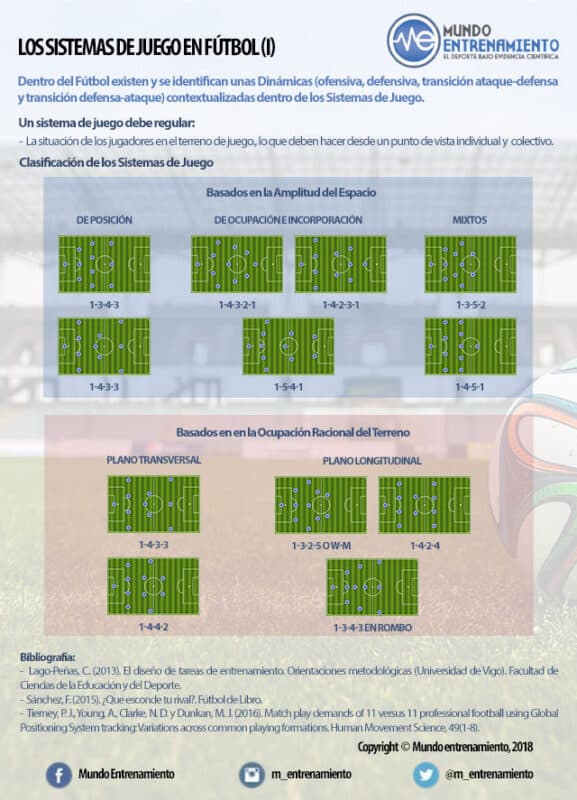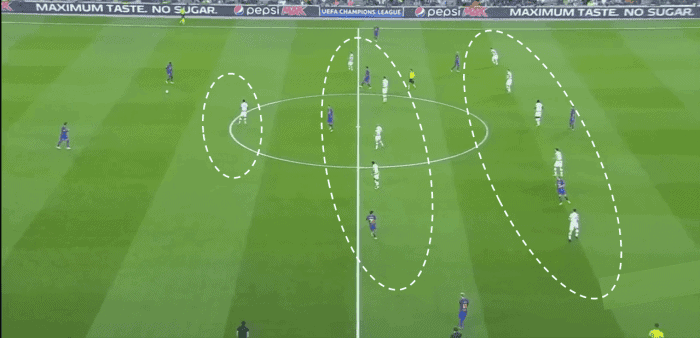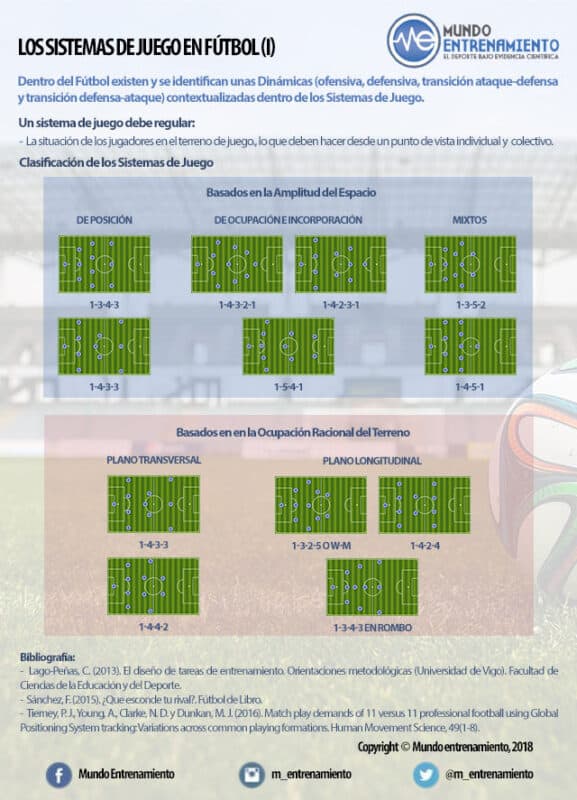In this article, the Game Systems will be analyzed as part of a sport that is a constant back and forth. Within Football, there are and can be identified some Dynamics (offensive phase, defensive phase, attack-defense transition, and defense-attack transition) contextualized within the Game Systems.
Game systems in football
The game systems in football “are the set of rules that govern individual, group, and collective actions with the aim of obtaining the maximum performance of the entire team and players” (1). According to Espar and Gerona (2004) cited in Lago-Peñas (1), a game system must regulate:
- The position of the players on the playing field.
- What they must do from an individual point of view.
- What they must do from a collective point of view.
The game system should never be considered an end in itself, shown as the only option, rigid and immovable (2). On the contrary, it must be and be shown as something flexible and at the service of the team and not the other way around, enslaving the collective, and excessively limiting the play of many players (2).
On the other hand, the static dimension understood as the game system or tactical device that represents the way players position themselves on the playing field (2). Specifically, they define the occupation of the playing space by the components of a team in attack and defense in the space outside the center of play or phase space (1).
Finally, and having as a reference the definitions presented in Sánchez (2), the following characteristics can be established for the game systems:
- Starting disposition observing the different dispositions and simple structures, lines, triangles, squares, diamonds…
- Interaction and functioning between players from the initial disposition.
- Groupings in sub-structures where players are responsible for specific missions defined by the coach.
- Rational occupation of certain zones or places in the defensive phase (retreat) and offensive phase (deployment).
Components of the game systems
Every game system when put into practice, must be characterized by possessing a series of elements such as (2):
- Individual technical-tactical means.
- Group tactical means.
- Relationships between players.
- Specific positions.
- Roles.
- The relationship between specific position and role.
- The space relationship.
- The characteristics of the players.
Classification of game systems in football
Game systems based on the width of the space
The characteristics of these game systems are founded from the strategic-tactical perspective, creating offensive width when the team has possession of the ball and defensive depth when the opposing team has possession of the ball (2). Specifically, their intention is to correctly occupy the playing field to seize the ball, and subsequently, create situations of uncertainty in the opposing team with the incorporation of players from back lines to more advanced ones (2).
The game systems called positional
These systems base their strategy on seeking and possessing maximum width on the playing field, to thus offer a greater number of possibilities and options to the ball holder (2). The most used formulas for these positional systems are the 1-3-4-3 and the 1-4-3-3.
The so-called occupation and incorporation systems
Firstly, from a tactical point of view, these systems seek offensive depth, incorporating players from back lines to more advanced lines to correctly occupy the spaces generated behind the lines of the opposing team (the constant search for the opponent’s weak zones) (2). As a result, these systems could also be called “those game systems based on a perfect rational occupation of the playing field, and a perfect Defense-Attack transition (Counterattack)” (2).
In summary, it is achieved that the possession of the ball and consequently, the initiative of the game, is held by the opponent and the weight of the game falls on them (2). Subsequently, after recovering the ball, the objective is clear, to direct the game seeking the free spaces generated by the opponent as a result of advancing their lines (2). Among these systems, the most notable are: 1-4-3-2-1, 1-4-2-3-1 and 1-5-4-1.
The mixed game systems
The main objective of these systems is to seek and perform a more balanced and less defined game, which gives it more advantage in areas of the field (2). Always depending on the use and positioning of its players, they can pursue different objectives, whether of incorporation and/or position (2). The most notable and interesting are: 1-3-5-2 and the 1-4-5-1.
Game systems based on the rational occupation of the field
These systems are characterized by having a perfect arrangement, establishing horizontal lines where players play very closely, and vertical lines, where defensive depth is sought (2). The rational occupation of the playing field occurs in two ways (2):
- Reorganization after the end of the play in front of the opponent’s goal.
- Restructuring after losing the ball, after which, a quick reordering of lines occurs.
The game systems that affect the transverse plane
The transverse occupation systems such as the 1-4-3-3 and the 1-4-4-2 are characterized by (2):
- Distribution of players in very populated horizontal lines.
- Increased protection (support) of players during the game.
- Reduction of distances covered by player.
- Solidity during the game.
- Priority of possession over depth.
However, these systems have a series of drawbacks that should be taken into account (2):
- Lack of depth during the game.
- Risk of imbalance (lack of linking players that connect one line with another).
- Difficulty in neutralizing the game between the opponent’s lines.
- Overuse of the “offside” resource.
- Problems collecting rebounds in the longitudinal plane.
The game systems that affect the longitudinal plane
These systems are defined through those procedures that show a distribution in which they position their players in such a way that they link the positions of one line with the other (2). Additionally, coaches must be very clear about two issues when implementing this type of system (2):
- Disposition of players with a high technical-tactical level (attack-defense transition).
- Having players with great commitment to effort.
The most common game systems in the transverse plane are the 1-3-2-5 or W-M, the 1-4-2-4 and the 1-3-4-3 in diamond (2). The prototype system that provides the greatest length is the 1-3-4-3 in diamond, whose main virtue is to facilitate the game between lines (priority of depth over possession), which gives greater depth (2).
When defending, they present a greater ability to neutralize the game between the opponent’s lines, without the need to provoke space reduction, based on continuous support and coverage between players (2).
Analysis of the game systems
Next, we analyze the game systems:
The 1-4-3-3 system
Characteristics of the 1-4-3-3
The main characteristics of this system are based on (2):
- Game system ideal for developing a good attack phase.
- Respects the principles of offensive tactics.
- Guarantees a lot of space on the offensive front (insertions and penetrations by full-backs, interiors, wingers, and forwards).
- Promotion of fast defense-attack transitions, seeking the opponent’s goal.
- Defensive moments that start with the center forward and continue with the respective defensive behaviors of the 1st and 2nd line of play.
- Importance of the goalkeeper and their relationship with the defensive line.
Variants of the 1-4-3-3
A variant does not modify a system as long as the alteration of a player or line does not alter the composition of that line (2). Regarding the above, we find the following variants of the 1-4-3-3 (2):
- 1-3-1-3-3
- 1-4-3-1-2
Unfavorable aspects of the 1-4-3-3
The main unfavorable aspects of this system are (2):
- In the absence of offensive width, there is a great density of players in the center, favoring the opponent’s defensive work.
- If the full-backs join the attack and the appropriate overlaps do not occur, we will facilitate the opponent’s counterattack by leaving free spaces due to uncoordinated offensive eagerness.
- When the midfield is not supported by the forwards or lacks the ability to recover balls.
- Not having a free defender who assumes offensive functions.
- If the forwards do not collaborate in the defensive play.
Physical demands of the 1-4-3-3
Regarding the physical demands (external load) that this game system implies (Figure 1), the following could be commented, having as a reference Tierney, Young, Clarke, and Dunkan (3):
- High demands in Total Distance covered (10,284 ± 879) compared to the systems 1-4-2-3-1 (10,044 ± 538), 1-4-4-2 (10,131 ± 583) and 1-3-4-3 (10,168 ± 449).
- Reduced distances at High Intensity of running (514 ± 204) compared to 1-4-2-3-1 (538 ± 174), the 1-3-4-3 (551 ± 171) and 1-3-5-2 (642 ± 215).
- Low requirements in distances at High Metabolic Load (1828 ± 518) compared to 1-3-4-3 (1855 ±301), 1-4-2-3-1 (1849 ± 301) and 1-3-5-2 (2025 ± 304).
- Scarce number of Accelerations (32 ± 8) and Decelerations (50 ± 14) compared to 1-4-2-3-1 (38 ± 8 and 61 ± 12).
- The Forwards reach high distances at High Intensity (802 ± 129) compared to 1-4-2-3-1 (353 ± 143), 1-4-4-2 (539 ± 256) and 1-3-4-3 (675 ± 222).
- The Forwards reach high distances at High Metabolic Load (2177 ± 107) compared to 1-4-2-3-1 (1452 ± 380), 1-4-4-2 (1816 ± 439) and 1-3-4-3 (2045 ± 425).
- The full-backs present long distances at High Metabolic Load (1958 ± 426) compared to 1-4-4-2 (1788 ± 399) and the 1-3-4-3 (1815 ± 174).

The 1-4-4-2 system
Characteristics of the 1-4-4-2
- It originates from the 1-4-3-3 system (arises by moving a forward back to the midfield area).
- Increases the ability to better distribute space and efforts (balances defensive and offensive actions).
- Versatility in the functions of certain players.
- Different positions on the playing field by the forwards:
- Both as center forwards.
- Open as wingers.
- Forming a wing.
- One as a center forward and the other as a winger.
- Increased control of the game in midfield.
- Importance of the goalkeeper and their relationship with the defensive line.
Variants of the 1-4-4-2
This has been a system that has been interpreted in different ways (2):
- 1-4-4-1-1
- 1-4-4-2 in diamond
- 1-4-2-2-2
Unfavorable aspects of the 1-4-4-2
The unfavorable aspects of the 1-4-4-2 system are (2):
- If playing with the lines very separated, it will favor the opponent’s offensive construction work.
- If playing with the team advanced:
- The failure or lack of decision of the goalkeeper in coming out for long balls will create serious problems.
- When the opponent plays with long balls behind the defense.
- If the opponent effectively combats the offside with walls.
- If the opponent effectively combats the offside with individual skill.
Physical demands of the 1-4-4-2
The conditional requirements (Figure 2) that this system demands are (3):
- Low demands in Total Distance covered (10,131 ± 583) compared to 1-3-4-3 (10,168 ± 449), 1-4-3-3 (10,284 ± 879) and 1-3-5-2 (10,528 ± 565).
- Game system with the fewest meters covered at High Intensity (497 ± 175) and at High Metabolic Load (1568 ± 257).
- Belongs to the group of game systems with a reduced number of Accelerations (33 ± 10), and is the system with the fewest Decelerations (49 ± 14).
- Low external conditional demands by playing position.

The 1-4-2-3-1 system
Characteristics of the 1-4-2-3-1
- This system originates from the 1-4-1-4-1.
- It is the most used system in professional Spanish football.
- Game system designed for third-line men to finish the offensive phase starting from back positions to arrive as a second wave (both in attack actions and clear counter-attacks).
- Rational distribution of the playing space, allowing better defensive layering of players and reinforcing the central zone.
- Complicates the game between the opponent’s lines.
- Great possibilities of recovering the ball in the opponent’s field (pressure with up to 4 players).
- Improves the possibilities of attacking play by layering the offensive positions of the center and wing.
- Greater possibilities of taking advantage of spaces when playing on the counter-attack.
Variants of the 1-4-2-3-1
This system presents various dispositions, the most common being (2):
- 1-4-3-1-2
- 1-4-1-3-2
Unfavorable aspects of the 1-4-2-3-1
- Excessive space to defend if not helped by the line of 3 midfielders or by full-backs.
- By reinforcing the central zone, empty spaces are left on the wing when defending, so it must be clear which players should occupy them and at what times.
- In attack, there is a risk of dividing the team, leaving a block of 6 players and the goalkeeper to defend.
Physical demands of the 1-4-2-3-1
The external conditional demands (Figure 3) that this game system demands are (3):
- Game system with the fewest total meters covered ((10,044 ± 538).
- Intermediate distances covered at High Intensity (538 ± 174) and at High Metabolic Load (1849 ± 301).
- High number of Accelerations (38 ± 8) and Decelerations (61 ± 12).
- The Forwards cover few total meters (8644 ± 984).
- The Forwards generate very few meters at High Intensity (353 ± 143).
- The Full-backs and Interiors/Wingers generate high distances at High Metabolic Load (2049 ± 344 and 2024 ± 282).

Football symposium: if you liked the article and want to expand your training in football, this interests you.
Conclusions
Firstly, Game Systems could be defined as the way players position themselves on the playing field, both in attack and defense. At the same time, this system should regulate the position of the players on the playing field, and what they must do from an individual and collective point of view.
Game Systems are classified into those based on the Width of the Space (Positional Games like the 1-3-4-3 and 1-4-3-3, Occupation and Incorporation Games like the 1-4-3-2-1, 1-4-2-3-1 and the 1-5-4-1 and Mixed Games like the 1-3-5-2 and 1-4-5-1) and those based on the Rational Occupation of the Field (Games in the Transverse Plane like 1-4-3-3 and 1-4-4-2 and Games in the Longitudinal Plane like 1-3-2-5, the 1-4-2-4 and the 1-3-4-3 in diamond).
On the other hand, from the point of view of physical demands (external load exclusively), it could be concluded that the 1-4-3-3 is a system that despite requiring high total distances demands low distances at High Intensity, High Metabolic Load, and Accelerations-Decelerations.
Regarding the 1-4-4-2 system, it is established as a game system with low demands in Total Distance, being the system with the fewest meters covered at High Intensity and High Metabolic Load. It is also present in the group of those systems that present the fewest Accelerations and Decelerations.
Finally, the 1-4-2-3-1 system is a game mode that presents with fewer total meters covered and intermediate demands of distance at High Intensity and High Metabolic Load. However, it is the system that most demands high Accelerations and Decelerations.

Bibliography
- Lago-Peñas, C. (2013). The design of training tasks. Methodological guidelines (University of Vigo). Faculty of Education and Sport Sciences.
- Sánchez, F. (2015). What does your rival hide?. Football Book.
- Tierney, P. J., Young, A., Clarke, N. D. and Dunkan, M. J. (2016). Match play demands of 11 versus 11 professional football using Global Positioning System tracking: Variations across common playing formations. Human Movement Science, 49(1-8).




